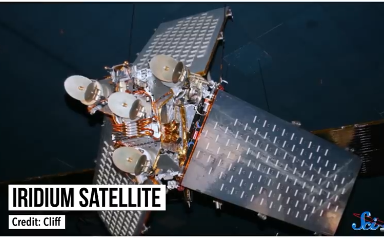(单词翻译:单击)
Climate change is a global problem.
气候变化是一个全球性问题。
And while it’s already affecting life on Earth, thanks to things like sea-level rise and more intense storms, the problems aren’t just happening near the ground.
虽然由于海平面上升和更强烈的风暴等因素,它已经在影响地球上的生命,但并不只有地表附近才有问题。
Climate change also affects objects in space.
气候变化也会影响太空中的物体。
Because, well... it’s making the upper atmosphere shrink.
因为……它会让上层大气收缩。
In the lower atmosphere, where we are, carbon dioxide acts as a greenhouse gas.
在我们所在的低层大气中,二氧化碳起着温室气体的作用。
It both absorbs and radiates infrared light — a.k.a. heat.
它会吸收并辐射红外线——也就是热。
So when waves of heat come off the ground and try to escape into space, they can be absorbed by the CO2 in the atmosphere.
因此,当热浪从地面散发到太空时,它们会被大气中的二氧化碳吸收。
Then, the carbon dioxide will release that energy.
然后,二氧化碳会释放能量。
And while some of it is released toward space, some will be sent back to Earth to warm things up.
其中一些被释放到太空中,另一些被返还至地球,使地球变暖。
This is what’s meant by the greenhouse effect.
这就是所谓的温室效应。
And as the amount of CO2 increases in the atmosphere, the amount of infrared light getting absorbed and sent back to Earth increases.
随着大气中二氧化碳含量的增加,被吸收并返还至地球的红外光数量也会增加。
That leads to warmer average temperatures, and the climate change we’re experiencing.
这会导致平均气温升高,以及我们正在经历的气候变化。
In the upper atmosphere, though, the story is different.
然而在上层大气中,情况就不同了。
As you travel higher above Earth, the atmosphere gets thinner and thinner. And carbon dioxide’s role changes.
当你在地球上空飞行时,大气会变得越来越稀薄。二氧化碳的作用也发生了变化。
Since there isn’t much air up there, the greenhouse effect isn’t as much of a thing.
因为那里空气较少,温室效应也就不那么严重了。
But there are a lot of free-floating oxygen atoms.
但是有很多自由漂浮的氧原子。

You don’t find many of those near the ground — you usually see oxygen molecules — but reactions in the upper atmosphere produce a lot of single-atom oxygen.
这样的分子在地面附近不多——你通常会看到氧分子——但是在高层大气中的反应会产生大量的单原子氧。
And occasionally, those atoms collide with molecules of carbon dioxide.
偶尔,这些原子会与二氧化碳分子发生碰撞。
When that happens, the atomic oxygen gives the CO2 a bit of energy and causes it to vibrate.
当这种情况发生时,原子氧会给予二氧化碳少量能量并使其振动。
Then, the CO2 can get rid of that energy by emitting infrared light — most of which escapes into space.
然后,二氧化碳可以通过释放红外光来释放能量——大部分红外光会逃逸到太空中。
Ultimately, as that heat dissipates away, the upper atmosphere cools down.
最终,随着热量消散,上层大气冷却下来。
So, as the amount of carbon dioxide increases, these collisions happen more and more often, and the upper atmosphere gets colder and colder — and in the process, it shrinks.
因此,随着二氧化碳含量的增加,这些碰撞发生的越来越频繁,上层大气变得越来越冷——在这个过程中,上层大气会收缩。
It’s just like how a balloon shrinks in cold weather: As gas cools down, its particles have less energy and can move closer to each other.
这就像气球在寒冷的天气里会收缩一样:当气体冷却时,它的粒子能量更少,可以相互靠近。
We’ve seen evidence of this happening in the upper atmosphere over the last two decades.
在过去的二十年里,我们已经在高层大气中发现了这种情况存在的证据。
And for spacecraft, it’s important — because many satellites that are orbiting Earth, including the International Space Station, are technically still in the atmosphere.
对于宇宙飞船来说,这很重要——因为许多绕地球轨道运行的卫星,包括国际空间站,从技术上讲仍然在大气层中。
I mean, it’s extremely thin up there, which is why it isn’t called the International Upper Atmosphere Station, but it’s still the atmosphere.
我的意思是,那里非常稀薄,所以它并不叫国际上层大气站,但那里仍然是大气层。
Normally, this means the satellites experience drag, where they’re constantly running into the particles in the atmosphere, losing energy, and dropping a little closer to Earth.
通常情况下,这意味着卫星会受到阻力,它们会不断地撞上大气中的粒子,失去能量,就会逐渐靠近地球。
In fact, for satellites that orbit less than about 600 kilometers above the surface, drag is one of the main forces that they feel besides gravity!
事实上,对于距离地面不到600公里的卫星来说,阻力是除重力之外的主要作用力之一。
And eventually, it’s what causes them to re-enter the lower atmosphere, where they burn up or crash.
最终,这是导致它们重新进入低层大气的原因,在那里它们会燃烧或坠毁。
But! As the upper atmosphere gets thinner thanks to climate change, the amount of drag goes down.
但是!由于气候变化,上层大气变薄,大气阻力下降。
And that means satellites stay in orbit longer.
这意味着卫星在轨道上停留的时间更长。
Like, this could be years longer, for those that are near that 600-kilometer altitude.
对于那些接近600公里高度的地区来说,这可能会多出几年的时间。
In some ways, this is great news for companies that build and launch satellites, since their spacecraft will last longer.
从某种意义上说,这对制造和发射卫星的公司来说是个好消息,因为他们的航天器寿命将会更长。
But... it also means everything up there will stick around longer.
但是…这也意味着大气层中的所有东西都会停留更长时间。
Like, the used upper sections of rockets, which sometimes stay in orbit.
比如用过的火箭上部,有时会留在轨道上。
Or any debris from the occasional satellite collision.
或者卫星偶尔相撞留下的残骸。
And as more objects stick around, there’s a higher and higher chance that they’ll collide, putting even more junk in orbit.
随着更多的物体粘在周围,它们碰撞的几率会越来越高,便会将更多垃圾送入轨道。
This is something people think about so much that there’s even a name for it:
这个问题人们经常思考,甚至还给它起了个专门的名字:
Kessler Syndrome, where space junk collides with other space junk, creating an ever-increasing amount of space junk.
“凯斯勒综合征”,指的是太空垃圾与其他太空垃圾相撞,从而产生越来越多的太空垃圾。
Also, to make the situation more complicated, the number of satellites in low Earth orbit is going to increase over the coming years, as companies launch hundreds of them to provide global internet services.
此外,让情况更加复杂的是,近地轨道卫星的数量在未来几年将会增加,因为公司将发射数百颗卫星来提供全球互联网服务。
So, we’re putting more satellites into orbit, while the atmosphere is becoming less capable of getting rid of them.
所以,我们把更多的卫星送入轨道,而大气层却越来越难以摆脱它们。
The good news is, people are working to deal with this, and are exploring options like a satellite traffic management system, similar to the one that exists for airplanes.
好消息是,人们正在努力解决这个问题,并在探索类似于卫星交通管理系统这种选择,类似于现有的飞机交通管理系统。
They’re also looking into some kind of specialized satellite that could capture pieces of debris and bring them to the lower atmosphere to burn up.
他们也在研究某种特殊的卫星,这种卫星可以捕捉碎片并将其带到低层大气中烧掉。
There are even conferences where scientists and engineers around the world get together to talk about ways of reducing the amount of junk in space.
甚至在一些会议中,世界各地的科学家和工程师聚在一起讨论减少太空垃圾的方法。
That collaboration and problem-solving is really cool, but it does also make you realize just how wide-reaching a problem climate change is.
这种合作解决问题的方法真的很酷,但它也让你意识到气候变化是一个涉及面很广的问题。
Because at the end of the day, fancy garbage truck satellites could help in space… but we’ll have other problems to deal with on the ground.
因为总有一天,先进的垃圾车卫星会在太空中发挥作用,但我们在地面上还有其他问题要处理。
Thanks for watching this episode of SciShow Space!
感谢收看本期太空科学秀!
If any kids in your life are space fans, they might enjoy some of the episodes we have over on SciShow Kids —
如果你身边有孩子是太空迷,他们可能会喜欢我们在《儿童科学秀》上展示的一些片段——
like our episode about where the Moon came from.
比如我们关于月亮的起源那一集。
If you want to check that out, along with the rest of our kids content, you can head over to youtube.com/scishowkids.
如果你想了解更多关于孩子的内容,可以登录youtube.com/scishowkids。


